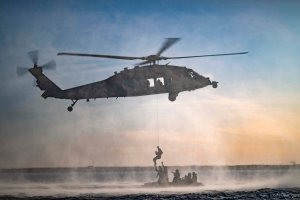
The white-winged scoter is a northern migratory waterfowl — a duck — with what the ornithologist at AllAboutBirds.org call “velvety black” feathers, an “upturned comma of white around the eye” and an “orange-tipped bill.” It nests in northern lakes across Canada, where it feeds on freshwater mussels, diving underwater to find them, holding its breath for up to a minute.
Though rarely seen in the lower 48 U.S. states, the scoter’s migratory range extends as far north as the river valleys of interior Alaska, which is probably why several of the ducks were lurking on the departure end of Eielson Air Force Base’s Runway 32 on the afternoon of May 28, 2024 — prime migration season — as a flight of four F-16Cs lifted off for a routine training flight.
An Air Force accident report released this week laid out what happened when the ducks and the jets met in mid-air, including the quick actions by the experienced pilot that led to a safe emergency landing, and grisly results for the waterfowl.
The four jets were from Eielson’s 18th Fighter Interceptor Squadron and were headed towards a simulated dogfight with four F-22s from Joint Base Elmendorf-Richardson, near Anchorage. Both planes regularly patrol Alaskan airspace as part of the NORAD air defense mission. The day’s flight was also a yearly evaluation for one of the F-16 pilots, who would act as the flight’s mission commander while a senior pilot graded his performance.
The F-16s took off 20 seconds apart in full afterburner, and perhaps the roar of the first jets startled the ducks into the air, but when the mission commander’s F-16 roared down the runway, the ducks were, well, in the way.
His F-16 struck several ducks as it lifted off, and “at least one” was “ingested” into the jet’s engine, causing an engine stall, a deadly midair event at low altitude. One of the wingmen in another F-16, along with witnesses on the ground, saw flames shooting out of the plane’s engine, a sure-fire sign that the engine was failing.
The pilot of the stricken jet, the report found, reacted perfectly.
He first radioed the other jets of the emergency, calling out “serious engine stall” on his formation’s radio frequency. He then moved to drop his two under-wing fuel tanks that each held 370 gallons of fuel, telling his wingman, “Stores are coming off here, does it look clear below?”
“You’re clear,” the second pilot replied, confirming the jets were over undeveloped forest outside Eielson with no sign of civilians beneath them. The pilot dropped the tanks.
Finally, the pilot swung the F-16 around for an emergency “flameout landing” on the Eielson runway, the procedure pilots are trained to execute when an engine fails during takeoff.
As the F-16 settled toward the runway, another plane was already landing, but air traffic controllers instructed the plane’s pilot to move quickly off the runway, which it did as the stricken F-16 touched down.

Eielson sits in a swampy forest along the Nanana River, a region renowned for wildlife during warm months in Alaska. “Daily and seasonal wildlife movements of resident and migratory species present an enduring risk to operations at the base,” the report said.
The base operates a Bird and Wildlife Strike Hazard program, or BASH, which is managed by U.S. Department of Agriculture wildlife experts who work on base. Between April and September, when ducks and many other migratory birds are passing through, the base activates 24-hour “increased dispersal efforts” to scare birds away from the flightline, the report said.
But no one had noticed the white-winged scoters on the day of the accident, and the base’s Bird Watch Condition was set to low for the afternoon flight.
“There is no evidence that the [pilot] or other base personnel could have taken reasonable actions to avert this collision,” the report concluded.
Back safely on the ground, maintenance crews determined the ducks had caused close to $1.3 million in damage to the jet, including the lost fuel tanks, which, at $50,000 each, were destroyed on impact. Searchers found their impact site in heavy woods a mile from the runway. Crews spent more than a month excavating the site to remove soil contaminated by the tanks’ fuel.
“The total time elapsed from the bird strike to taxing clear was just under three minutes,” the report said, while investigators “discovered evidence of bird remains scattered throughout the engine.”
The latest on Task & Purpose
- Army infantry officer calls new XM7 ‘unfit for use as a modern service rifle’
- Attempted Fort Leavenworth prison break leaves military inmate tangled on fence
- When Americans, Germans and POWs fought the SS from the walls of a castle
- This Army combat medic fought off an active shooter and rendered first aid
- This 53 aircraft ‘elephant walk’ has everything you’d need for a war in the Pacific

